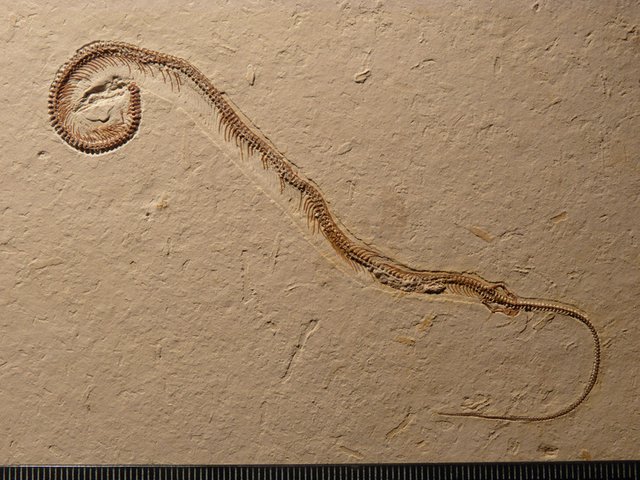How Snakes Lost Their Legs
Not everyone may be a reptile expert, but we all know one very important fact about snakes: they simply do not have legs. Instead of crawling or running like other legged animals, snakes rely on muscle contractions to move through their environment, in a sense letting their scales to the "walking" by pushing the body forward against the substrate. The video below explains exactly how these animals manage to move so efficiently despite their complete lack of limbs.
However, you might be surprised to learn snakes haven't always been the legless reptiles we know them to be today. Closely related to lizards (both belonging to the same squamate group), we know that snakes once had legs, but overtime these appendages were reduced and eventually lost (though they do still carry inactive "leg genes"). And while we know that snakes were once legged animals, we weren't sure for a long time exactly why or how they became legless. The leading theory was that these animals evolved from marine species, and simply did not require the use of legs since they were living an aquatic lifestyle, and only later made the shift to land. Others suggested that perhaps as the snake's body began to elongate, movement on its legs became more and more difficult, and they lost their legs in favor of a more efficient means of locomotion. With few fossils showing the transition from legged to legless, herpetologists and paleontologists have remained fairly baffled about about what caused the snake's evolution.

In order to begin understanding the shift, we had to look at other members of the squamate order; while snakes are recognized as a single evolutionary group, the evolution of limblessness is actually more common among squamates than most people realized. The loss of limbs has independently occurred on more than 20 separate occasions within the squamate order, and generally correlated with body elongation; today there are several species of legless lizards that closely resemble snake species, and even more species that have drastically reduced their limb size. This suggested that there had to be some sort of biomechanical reason for this evolution to occur repeatedly.

Legless lizard on the left, snake on the right.
A recently discovered fossil found in Brazil offers some key insight into this bizarre evolution. Dating back 100-146 million years, the fossil is an undisputed snake, however this particular organism still had legs.



This particular fossil is actually quite revealing to the scientists studying it. The elongate body, combined with these small limbs, is actually a form we commonly associate with fossorial, or burrowing, species. There are many fossorial lizards alive today with these drastically reduced limbs that allow them to easily move underground; the limbs on this fossil snake suggest it was a burrowing species moving towards complete leglessness. This revelation completely blew old theories out of the water; it was clear that snake evolution took place on land rather than at sea. This is further backed up by the existence of legless lizards, as many of these modern-day animals spend virtually all of their lives beneath the surface, where their lack of limbs enables them to burrow with ease.

Interestingly, Christians are finding the discovery of this fossil equally important. In the Bible, Genesis 3:14 to be precise, the snake that approaches Eve in the Garden of Eden is described as having four legs; after Adam and Eve are cast from the Garden, God punishes the snake by taking away its legs.
And the LORD God said unto the serpent, Because thou hast done this, thou art cursed above all cattle, and above every beast of the field; upon thy belly shalt thou go, and dust shalt thou eat all the days of thy life: (Genesis 3:14)
With physical evidence of snakes once having legs, many Christians are excited. How could Moses (who was believed to have written Genesis, along with Joshua) have known about this connection unless he had a greater connection with God?

We often make the mistake of believing snakes are more simple animals because of their lack of limbs. The fact is that they are not less-evolved, rather they have come to favor a body form that best suites their lifestyle. Even without limbs, snakes have conquered the land, trees, underground and even seas...and it's all thanks to the earliest legged snakes. This fossilized creature, bizarre as it may have been, paved the way for the success of all serpents.
Video Link: 1
Image Links: 1, 2, 3, 4, 5, 6, 7

All animals are equally evolved. This is what most people don't get. They just have adopted for their unique environment.
wow. snake have legs??
Not anymore, they once did though. They do still have the genes for legs, however these are inactive, so they do not grow legs.
Nice. This is the type of posting I like to see; the odd and strange. Following...thanks.
Oh, and if you like the strange and hidden things....

loved you article herpetologyguy check out this one https://steemit.com/animals/@whitedolphin/dying-for-your-pleasure-the-extinction-of-orang-utans
That was a great read!
You have provided some awesome information!
I love your post, It's very detailed with pictures of the fossilized snake with limbs!
Snakes have come a long way!
Thank you for sharing this very interesting post! :)
I'm so happy I found this page! heh.
I'd tag you in my convergent evolution post, but it seems you can't edit something after a week!
Following!
thank you for sharing